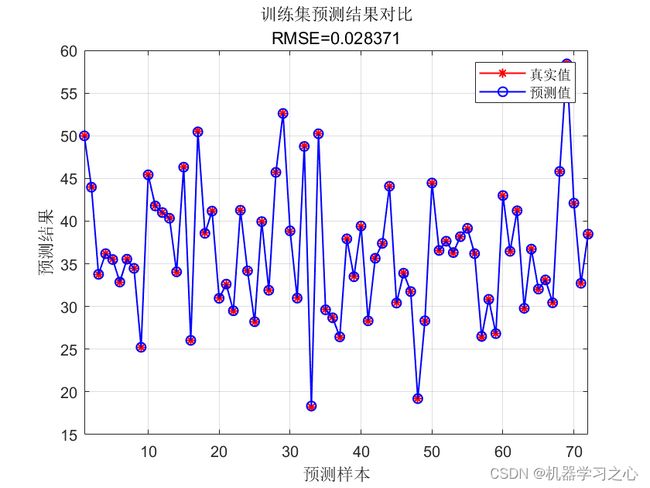回归预测 | MATLAB实现RUN-XGBoost龙格库塔优化极限梯度提升树多输入回归预测
回归预测 | MATLAB实现RUN-XGBoost多输入回归预测
目录
-
- 回归预测 | MATLAB实现RUN-XGBoost多输入回归预测
-
- 预测效果
- 基本介绍
- 程序设计
- 参考资料
预测效果
基本介绍
MATLAB实现RUN-XGBoost多输入回归预测(完整源码和数据)
1.龙格库塔优化XGBoost,数据为多输入回归数据,输入7个特征,输出1个变量,程序乱码是由于版本不一致导致,可以用记事本打开复制到你的文件。
2.运行环境MATLAB2018b及以上。
3.附赠案例数据可直接运行main一键出图~
4.注意程序和数据放在一个文件夹。
5.代码特点:参数化编程、参数可方便更改、代码编程思路清晰、注释明细。
程序设计
- 完整源码和数据获取方式(资源出下载):MATLAB实现RUN-XGBoost多输入回归预测。
%% Main Loop of RUN
it=1;%Number of iterations
while it<Max_iteration
it=it+1;
f=20.*exp(-(12.*(it/Max_iteration))); % (Eq.17.6)
Xavg = mean(X); % Determine the Average of Solutions
SF=2.*(0.5-rand(1,pop)).*f; % Determine the Adaptive Factor (Eq.17.5)
for i=1:pop
[~,ind_l] = min(Cost);
lBest = X(ind_l,:);
[A,B,C]=RndX(pop,i); % Determine Three Random Indices of Solutions
[~,ind1] = min(Cost([A B C]));
% Determine Delta X (Eqs. 11.1 to 11.3)
gama = rand.*(X(i,:)-rand(1,dim).*(ub-lb)).*exp(-4*it/Max_iteration);
Stp=rand(1,dim).*((Best_pos-rand.*Xavg)+gama);
DelX = 2*rand(1,dim).*(abs(Stp));
% Determine Xb and Xw for using in Runge Kutta method
if Cost(i)<Cost(ind1)
Xb = X(i,:);
Xw = X(ind1,:);
else
Xb = X(ind1,:);
Xw = X(i,:);
end
SM = RungeKutta(Xb,Xw,DelX); % Search Mechanism (SM) of RUN based on Runge Kutta Method
L=rand(1,dim)<0.5;
Xc = L.*X(i,:)+(1-L).*X(A,:); % (Eq. 17.3)
Xm = L.*Best_pos+(1-L).*lBest; % (Eq. 17.4)
vec=[1,-1];
flag = floor(2*rand(1,dim)+1);
r=vec(flag); % An Interger number
g = 2*rand;
mu = 0.5+.1*randn(1,dim);
% Determine New Solution Based on Runge Kutta Method (Eq.18)
if rand<0.5
Xnew = (Xc+r.*SF(i).*g.*Xc) + SF(i).*(SM) + mu.*(Xm-Xc);
else
Xnew = (Xm+r.*SF(i).*g.*Xm) + SF(i).*(SM)+ mu.*(X(A,:)-X(B,:));
end
% Check if solutions go outside the search space and bring them back
FU=Xnew>ub;FL=Xnew<lb;Xnew=(Xnew.*(~(FU+FL)))+ub.*FU+lb.*FL;
CostNew=fobj(Xnew);
if CostNew<Cost(i)
X(i,:)=Xnew;
Cost(i)=CostNew;
end
%% Enhanced solution quality (ESQ) (Eq. 19)
if rand<0.5
EXP=exp(-5*rand*it/Max_iteration);
r = floor(Unifrnd(-1,2,1,1));
u=2*rand(1,dim);
w=Unifrnd(0,2,1,dim).*EXP; %(Eq.19-1)
[A,B,C]=RndX(pop,i);
Xavg=(X(A,:)+X(B,:)+X(C,:))/3; %(Eq.19-2)
beta=rand(1,dim);
Xnew1 = beta.*(Best_pos)+(1-beta).*(Xavg); %(Eq.19-3)
for j=1:dim
if w(j)<1
Xnew2(j) = Xnew1(j)+r*w(j)*abs((Xnew1(j)-Xavg(j))+randn);
else
Xnew2(j) = (Xnew1(j)-Xavg(j))+r*w(j)*abs((u(j).*Xnew1(j)-Xavg(j))+randn);
end
end
FU=Xnew2>ub;FL=Xnew2<lb;Xnew2=(Xnew2.*(~
if rand<w(randi(dim))
SM = RungeKutta(X(i,:),Xnew2,DelX);
Xnew = (Xnew2-rand.*Xnew2)+ SF(i)*(SM+(2*rand(1,dim).*Best_pos-Xnew2)); % (Eq. 20)
FU=Xnew>ub;FL=Xnew<lb;Xnew=(Xnew.*(~(FU+FL)))+ub.*FU+lb.*FL;
CostNew=fobj(Xnew);
if CostNew<Cost(i)
X(i,:)=Xnew;
Cost(i)=CostNew;
end
end
end
end
% End of ESQ
%% Determine the Best Solution
if Cost(i)<Best_score
Best_pos=X(i,:);
Best_score=Cost(i);
end
end
% Save Best Solution at each iteration
curve(it) = Best_score;
disp(['it : ' num2str(it) ', Best Cost = ' num2str(curve(it) )]);
end
end
参考资料
[1] https://blog.csdn.net/kjm13182345320/article/details/128577926?spm=1001.2014.3001.5501
[2] https://blog.csdn.net/kjm13182345320/article/details/128573597?spm=1001.2014.3001.5501



